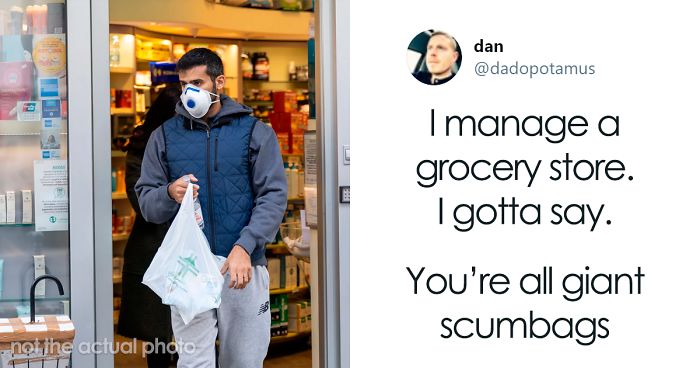
Angry Retail Managers Are Revealing How Coronavirus Is Bringing Out The Worst In Customers
As panic buyers flood Targets, Walmarts, and local businesses to stockpile on pretty much everything, many of them forget that those who refill the shelves are humans, too. Frustrated with recent shopping behavior, grocery store manager @dadopotamus turned to Twitter to share his emotions.
“I manage a grocery store. I gotta say. You’re all giant scumbags,” he wrote.
Other retail workers, as well as sensible buyers, immediately joined in to share their experiences. Pretty soon the thread went viral, sparking a discussion about how we all should behave during this crisis. While many aspects are still up for debate, one thing is certain, though. Far too many retail workers are treated like crap.
Image credits: Denis Sokol
Image credits: dadopotamus
Image credits: BzLindberg
Image credits: DunBiken
Image credits: TSannis
Image credits: OpheliasMarbles
Image credits: dadopotamus
However, not all buyers are changing their shopping habits yet. According to a recent survey, about 54 percent of millennials say the new coronavirus has significantly or somewhat impacted their purchase decisions, while the same applies to only 33% of baby boomers, 42% of Gen X, and 49% of Gen Z. The results also showed some differences between how men and women are responding to the crisis. For example, even though more women (71 percent) than men (60 percent) reported being “worried about the coronavirus,” nearly half of the men surveyed (47 percent) said it has impacted their purchase decisions, versus 41 percent of women. Furthermore, 38 percent of men agreed that it had also impacted where and how they shop compared to 33 percent of women.
Greg Petro is the CEO of First Insight, a company that gathers real-time consumer data through the use of online consumer engagement and applies predictive analytic models powered by machine learning and AI to create actionable insights. He told Bored Panda that, “In response to the coronavirus outbreak, men’s behavior is changing even more dramatically than females’, which may be instinctual, habitual or due to the fact that men and women use different areas of the brain for solving problems and accomplishing tasks.”
“It’s been documented that men and women shop differently even under normal conditions. Men are more likely to be on a hunting mission for a specific item, while women tend to browse more. This difference has likely contributed to the higher rate of behavior change among men. As the virus spreads, shopping behaviors of both men and women are likely to be impacted even more profoundly.”
According to Petro, even if consumers do not intentionally alter their spending behavior in the face of the outbreak, market and supply chain disruptions will force behavior changes. “For the first time in the history of modern retail, supply is constrained as retail supply chains have experienced significant disruption. This impact will likely be felt starting in April and May. Production may be unable to catch up to demand, which would affect summer, fall, and potentially holiday sales.” However, if retailers and brands act quickly, they can lock in their share of scarce supply and be able to offer products to consumers as planned to enable shopping to stay on track.
Image credits: TwoLs60
Image credits: COLOStormChaser
Image credits: dadopotamus
And while photos of empty store shelves on social media give the appearance that the United States is running out of food, the nation’s biggest retailers, dairy farmers, and meat producers say the reality is quite different. According to them, the food supply chain remains intact and has been ramping up to meet the growing demand.
“There is food being produced. There is food in warehouses,” Julie Anna Potts, chief executive of the North American Meat Institute told The New York Times. “There is plenty of food in the country.”
“Our stores are getting stocked every day,” Ron Vachris, chief operating officer of Costco, added. “Transportation is functioning, our suppliers are working around the clock and the flow of goods is strong.”
The National Chicken Council confirmed that it was not seeing any disruptions in production and noted that there were “ample surplus supplies of chicken in cold storage” — totaling more than 950 million pounds, according to official data.
Still, panic buyers are testing the food system’s capacity. Retailers say the panic buying started about 2 weeks ago when customers couldn’t get a hold of hand sanitizers and wipes which at the time were in short supply. And that is what set off the stockpiling frenzy seen in recent days, including bread, canned goods, milk, and frozen food.
“Meanwhile, retail outlets other than grocery stores are closing or reducing their operating hours, and consumers are reacting, with thirty percent of consumers overall reporting they’re shopping less in-store,” Petro added. “To minimize in-store shopping exposure, forty-seven percent of Gen Zers say they’re using curbside pickup services and thirty percent of Millennials report that they use BOPIS (buy online, pick up in-store) options. As the outbreak unfolds, one thing we can all do to help is to shop based on our actual needs and to assist at-risk people with their shopping. We can also help local independent retailers by purchasing gift cards directly from them to use for future purchases. This applies to local restaurants as well. They need the cash flow, and they need it now.”
According to the expert, one mistake buyers may be particularly tempted to make is to stock up even beyond what they and their families truly need, thereby decreasing others’ ability to secure even a baseline supply of essential products. “The recent run on toilet paper in the U.S. is an example of this. On the flip side, it is also unwise to hold off on purchases, thinking that prices may come down. With shrinking supply levels looming, availability is unlikely to improve in the short- to mid-term. If you see something you know you need or want, making the purchase now will avoid disappointment and frustration later.”
Image credits: ashleysweetlyx
Image credits: robynski
Image credits: Alean4
Image credits: TheGreatDanBaer
Image credits: Murdersmith
Image credits: SUZAN916
Image credits: DMoPrime
Image credits: plantz3610
Image credits: amkay2012
Image credits: chrystadawn
Image credits: jonmnelson
Image credits: JulzyaIsaidit
Image credits: TravelinTrilogy
Here’s what people said about the discussion
No, we are not all scumbags. I didn’t hoard any food or supplies. I keep shopping every week like I normally do. Some of us have common sense and decency. Regardless, I would never want to work in retail. Some people are real jerks.
Same, i went online and ordered 24 rolls of toilet paper, that will do me, we have plenty of food at the moment and me and my wife are healthy adults that don't need to hoard stuff and be selfish a******s.
Load More Replies...I'm happy that the stores around here are indeed putting limits on how many of an item that people can buy. Contrary to "Dan"'s assertion in one of the tweets above, there are "critical thinking" reasons for placing limits on sales: ensuring that others can buy necessary items, to avoid price-gouging resales, and to discourage selfish hoarding.
Same! There's a limit of 2 packets of loo roll per customer. Result: there's still loo roll on the shelves. 2 bottles of hand sanitiser too. There's none of that left right now but at least we don't get price-gougers.
Load More Replies...The question "Do you have more in the back?" isn't always stupid, but it depends heavily on the store and type of product, and customers often aren't aware of that. My mom worked at a grocery store when I was little and I visited her often after school and helped around the store for fun, but I also worked at two other stores stocking shelves later on. I can only speak from my own experience, but not all stores have freezers/fridges in the back and the storage area has always been rather small. If there is a bulky item on sale, though, there really might be some in the back, sometimes only three or four of them fit on the salesfloor. I got my cleaning kit from the store after asking politely and the friendly employee actually got it for me. Sadly, retail workers don't get tips.
This is why I am always polite to store employees, crazy stupid virus panic shopping or not. I shop normally and I make sure I ask how the employees at the supermarket are doing and take a few minutes to tell them they're doing great, despite how things are. It's not their fault the rest of humanity have become selfish douchebags so treat 'em and each other with respect eh? Hells, our Prime Minister here in Australia is telling people to calm the f*ck down and don't panic shop..but no one is listening as usual. I will continue to tell people where they can check for the necessities if they can't find them and help out wherever I can by NOT hoarding
I had a customer ask me to show him where the pasta normally is to prove we didn't have any. So I showed him a empty shelf.
I am a 17 year old 5 ft 2 girl, and I work in a grocery store. It is absolutely TERRIFYING to be yelled at by a 6 ft something grown man because we are out of toilet paper. I can't do anything about it. I hate my job so much right now.
I don't Know if it's just me, but 2020 has been real pain in the a**e. Kobe bryant dies, coronavirus starts, schools are getting canceled; whats next?they going to quarantine countries?!?!?
I was in line at Aldi's the other day with less than 15 items. There was a row of groceries upon groceries on the belt, but no person. There was no room to put anything down, so I waited. A minute later, a rotten woman blasts me with her cart. "Cant you see my stuff is here already? I bit my tongue. She gets up to the cashier (a super sweet girl who had been working opening to close for 3 days). "Where the F**k is your chicken?" The lady barks. The cashier sweetly said, "I'm sorry ma'am. If it's not on the shelf, we are all out." Nasty woman, "What do you know? Your just the cashier. Get your manager up here!" I couldn't take it anymore. I immediately (and quite loud) thanked the girl for being there for days and hours, putting herself in harm's way, so we could have groceries! I told her what a great job she was doing, and started to make small talk. Nasty woman- "Excuse me! Its NOT your turn and I'm waiting for my F***ing chicken! Mind your own business! Continued below...
Me- "I actually AM minding my business, and buying groceries just like you. I'm just thanking this girl for being here so we can have groceries! And THERE IS NO F***ING CHICKEN! Her face was amazed. Everyone was amazed. A few people even clapped. People need to realize it's NOT OK to be abusive to people just for doing thier jobs! They aren't the only beings in "crisis" here. I know people in that store/line thought the same thing I did that day, but I really hope others, who aren't kind to others had an "Ah-ha" moment! Every store I've been in since, I made it an absolute point to thank every single employee I see! Even if it's just a minute of happiness, at least they have it! #BeKind #BecauseISaidIWould
Load More Replies...I've been trying to be extra polite and friendly (from a distance) to retail staff. Even without having to deal with horrible people, they're probably stressed enough about being in close contact with the whole damn town. It's doesn't cost a thing to be considerate towards others.
It’s actually the cleaning, omg... the cleaning...disinfecting and taking precautions for everything. That’s on top of all the duties that make up an 8 hour day. And stressful when people aren’t taking covid seriously, and complaining how they shouldn’t have to follow these rules meant for safety. If you don’t clean, then you’re one of the reasons 1.pandemic isn’t ending 2.somebody died, because you didn’t disinfect properly (not that you’d know, but you know there would be tiny feeling everyday saying... did you do everything you could? You might have killed somebody. Maybe you did, maybe you didn’t ... I dunno... there’s no way to find out). So here’s my point, thanks for being nice. You don’t know, but it makes a huge difference
Load More Replies...The media is bringing out the worst in people. It's a 2-3 week quarantine not an Apocalyptic evacuation. Should we take this seriously? Yes. Should we act like it's the end of the world? NO. Get a grip people. If the media would report on the percentage of those that have actually recovered from this instead of those dying we all wouldn't be going this nuts over it.
If numbers are taken on a state/regional basis rather national (where numbers are consolidated), mortality rate is probably higher than reported. The morality rate in Washington state is up there with Italy... about 1 in 17. That's way higher than the reported 2-3+% at the national level. Also, lack of tests means reported numbers are not accurate. Be it known infected or known deaths. Known Corona deaths are only those were known to be positive before they died. Due to the dearth of tests, it is highly unlikely we will ever know how many died before being tested. They aren't testing dead people.
Load More Replies...It's not even just on a store level- manufacturing companies only make so much- they can increase production but only to a certain level. My mom works grocery- her store is being limited in what it can bring in now because they want to keep things evenly distributed between stores. They placed huge orders when the first few days of the hoarding plague hit but now they're only allowed to order less then half their non plague time orders per department so the shelves are only going to get emptier if idiots keep being idiots
'Murica. Haven't seen any panic buying or abusive behaviour towards staff in my country.
My husband was at a Sams Club last night night getting some vegetables (still sold out of meat) and a worker stopped him to let him know workers were unloading 6 pallets of toilet paper if he had time to wait! We had already found some in another store and ordered some online, but it was really nice of her to do that! So far we’ve run into nice customers and workers!
Screaming and yelling and threatening store employees is not going to get shelves stocked any faster. Please calm down and understand that these people are simply doing their jobs.
Wow, that's crazy.. and not in a positive way. Is not common sense to be always polite ( even if you have to ask questions that are considered "stupid", at least you were polite) and treat stuffs and places like you treat your home (well..maybe I don't want to see the home of these costumers)? I see a lot of immaturity in costumers who shout at the personals and treat that stores like dumps. What should we do to help these people growing? ( real question, not ironic)
Maybe with a spike in sales these people will see some of that profit on their paycheck. A large bonus all around sounds well deserved. Or tip your grocer? The grocers I've seen in my neighborhood have still been kind and in high spirits. Bless them.
Load More Replies...We are not all scumbags! Lots of us are polite, respectful and not hoarding. Retail must be horrific, and there is no excuse for people being rude and abusive... but let's be honest it isn't the worse... what about drs, nurses & healthcare assistants who are working flat out in hospitals that are already at capacity because it's winter and that's how the nhs works.
No, we are not all scumbags. I didn’t hoard any food or supplies. I keep shopping every week like I normally do. Some of us have common sense and decency. Regardless, I would never want to work in retail. Some people are real jerks.
Same, i went online and ordered 24 rolls of toilet paper, that will do me, we have plenty of food at the moment and me and my wife are healthy adults that don't need to hoard stuff and be selfish a******s.
Load More Replies...I'm happy that the stores around here are indeed putting limits on how many of an item that people can buy. Contrary to "Dan"'s assertion in one of the tweets above, there are "critical thinking" reasons for placing limits on sales: ensuring that others can buy necessary items, to avoid price-gouging resales, and to discourage selfish hoarding.
Same! There's a limit of 2 packets of loo roll per customer. Result: there's still loo roll on the shelves. 2 bottles of hand sanitiser too. There's none of that left right now but at least we don't get price-gougers.
Load More Replies...The question "Do you have more in the back?" isn't always stupid, but it depends heavily on the store and type of product, and customers often aren't aware of that. My mom worked at a grocery store when I was little and I visited her often after school and helped around the store for fun, but I also worked at two other stores stocking shelves later on. I can only speak from my own experience, but not all stores have freezers/fridges in the back and the storage area has always been rather small. If there is a bulky item on sale, though, there really might be some in the back, sometimes only three or four of them fit on the salesfloor. I got my cleaning kit from the store after asking politely and the friendly employee actually got it for me. Sadly, retail workers don't get tips.
This is why I am always polite to store employees, crazy stupid virus panic shopping or not. I shop normally and I make sure I ask how the employees at the supermarket are doing and take a few minutes to tell them they're doing great, despite how things are. It's not their fault the rest of humanity have become selfish douchebags so treat 'em and each other with respect eh? Hells, our Prime Minister here in Australia is telling people to calm the f*ck down and don't panic shop..but no one is listening as usual. I will continue to tell people where they can check for the necessities if they can't find them and help out wherever I can by NOT hoarding
I had a customer ask me to show him where the pasta normally is to prove we didn't have any. So I showed him a empty shelf.
I am a 17 year old 5 ft 2 girl, and I work in a grocery store. It is absolutely TERRIFYING to be yelled at by a 6 ft something grown man because we are out of toilet paper. I can't do anything about it. I hate my job so much right now.
I don't Know if it's just me, but 2020 has been real pain in the a**e. Kobe bryant dies, coronavirus starts, schools are getting canceled; whats next?they going to quarantine countries?!?!?
I was in line at Aldi's the other day with less than 15 items. There was a row of groceries upon groceries on the belt, but no person. There was no room to put anything down, so I waited. A minute later, a rotten woman blasts me with her cart. "Cant you see my stuff is here already? I bit my tongue. She gets up to the cashier (a super sweet girl who had been working opening to close for 3 days). "Where the F**k is your chicken?" The lady barks. The cashier sweetly said, "I'm sorry ma'am. If it's not on the shelf, we are all out." Nasty woman, "What do you know? Your just the cashier. Get your manager up here!" I couldn't take it anymore. I immediately (and quite loud) thanked the girl for being there for days and hours, putting herself in harm's way, so we could have groceries! I told her what a great job she was doing, and started to make small talk. Nasty woman- "Excuse me! Its NOT your turn and I'm waiting for my F***ing chicken! Mind your own business! Continued below...
Me- "I actually AM minding my business, and buying groceries just like you. I'm just thanking this girl for being here so we can have groceries! And THERE IS NO F***ING CHICKEN! Her face was amazed. Everyone was amazed. A few people even clapped. People need to realize it's NOT OK to be abusive to people just for doing thier jobs! They aren't the only beings in "crisis" here. I know people in that store/line thought the same thing I did that day, but I really hope others, who aren't kind to others had an "Ah-ha" moment! Every store I've been in since, I made it an absolute point to thank every single employee I see! Even if it's just a minute of happiness, at least they have it! #BeKind #BecauseISaidIWould
Load More Replies...I've been trying to be extra polite and friendly (from a distance) to retail staff. Even without having to deal with horrible people, they're probably stressed enough about being in close contact with the whole damn town. It's doesn't cost a thing to be considerate towards others.
It’s actually the cleaning, omg... the cleaning...disinfecting and taking precautions for everything. That’s on top of all the duties that make up an 8 hour day. And stressful when people aren’t taking covid seriously, and complaining how they shouldn’t have to follow these rules meant for safety. If you don’t clean, then you’re one of the reasons 1.pandemic isn’t ending 2.somebody died, because you didn’t disinfect properly (not that you’d know, but you know there would be tiny feeling everyday saying... did you do everything you could? You might have killed somebody. Maybe you did, maybe you didn’t ... I dunno... there’s no way to find out). So here’s my point, thanks for being nice. You don’t know, but it makes a huge difference
Load More Replies...The media is bringing out the worst in people. It's a 2-3 week quarantine not an Apocalyptic evacuation. Should we take this seriously? Yes. Should we act like it's the end of the world? NO. Get a grip people. If the media would report on the percentage of those that have actually recovered from this instead of those dying we all wouldn't be going this nuts over it.
If numbers are taken on a state/regional basis rather national (where numbers are consolidated), mortality rate is probably higher than reported. The morality rate in Washington state is up there with Italy... about 1 in 17. That's way higher than the reported 2-3+% at the national level. Also, lack of tests means reported numbers are not accurate. Be it known infected or known deaths. Known Corona deaths are only those were known to be positive before they died. Due to the dearth of tests, it is highly unlikely we will ever know how many died before being tested. They aren't testing dead people.
Load More Replies...It's not even just on a store level- manufacturing companies only make so much- they can increase production but only to a certain level. My mom works grocery- her store is being limited in what it can bring in now because they want to keep things evenly distributed between stores. They placed huge orders when the first few days of the hoarding plague hit but now they're only allowed to order less then half their non plague time orders per department so the shelves are only going to get emptier if idiots keep being idiots
'Murica. Haven't seen any panic buying or abusive behaviour towards staff in my country.
My husband was at a Sams Club last night night getting some vegetables (still sold out of meat) and a worker stopped him to let him know workers were unloading 6 pallets of toilet paper if he had time to wait! We had already found some in another store and ordered some online, but it was really nice of her to do that! So far we’ve run into nice customers and workers!
Screaming and yelling and threatening store employees is not going to get shelves stocked any faster. Please calm down and understand that these people are simply doing their jobs.
Wow, that's crazy.. and not in a positive way. Is not common sense to be always polite ( even if you have to ask questions that are considered "stupid", at least you were polite) and treat stuffs and places like you treat your home (well..maybe I don't want to see the home of these costumers)? I see a lot of immaturity in costumers who shout at the personals and treat that stores like dumps. What should we do to help these people growing? ( real question, not ironic)
Maybe with a spike in sales these people will see some of that profit on their paycheck. A large bonus all around sounds well deserved. Or tip your grocer? The grocers I've seen in my neighborhood have still been kind and in high spirits. Bless them.
Load More Replies...We are not all scumbags! Lots of us are polite, respectful and not hoarding. Retail must be horrific, and there is no excuse for people being rude and abusive... but let's be honest it isn't the worse... what about drs, nurses & healthcare assistants who are working flat out in hospitals that are already at capacity because it's winter and that's how the nhs works.

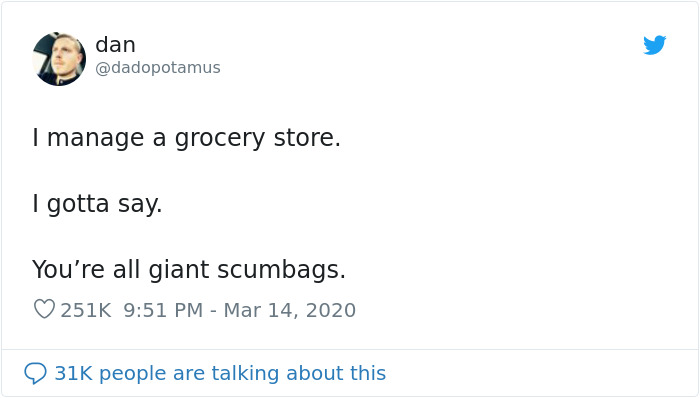
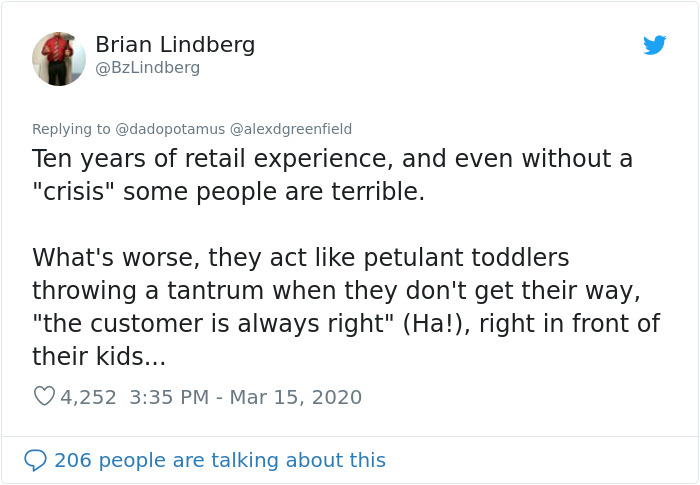
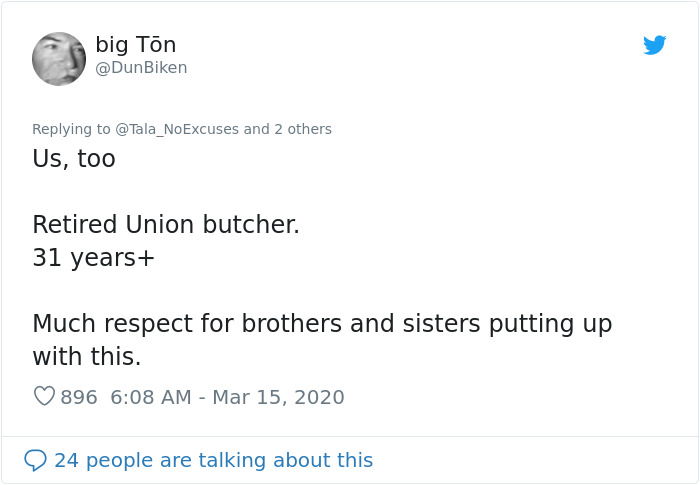
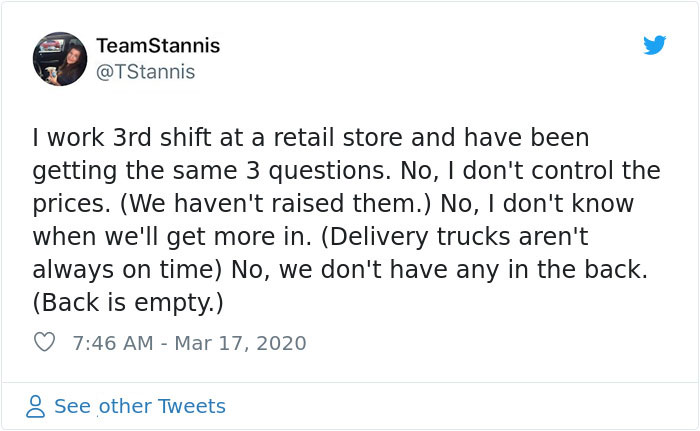
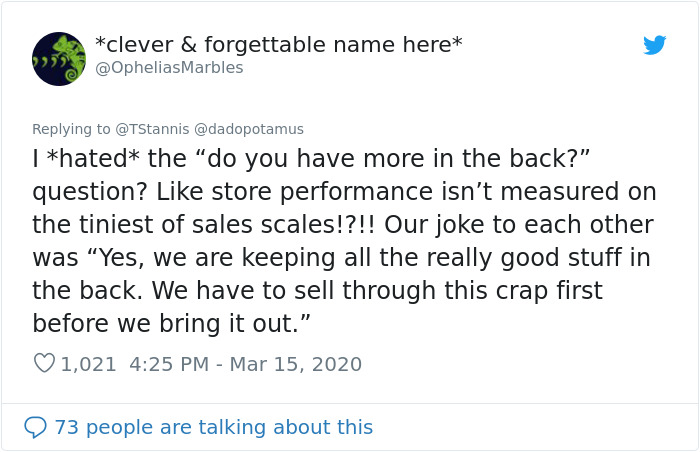
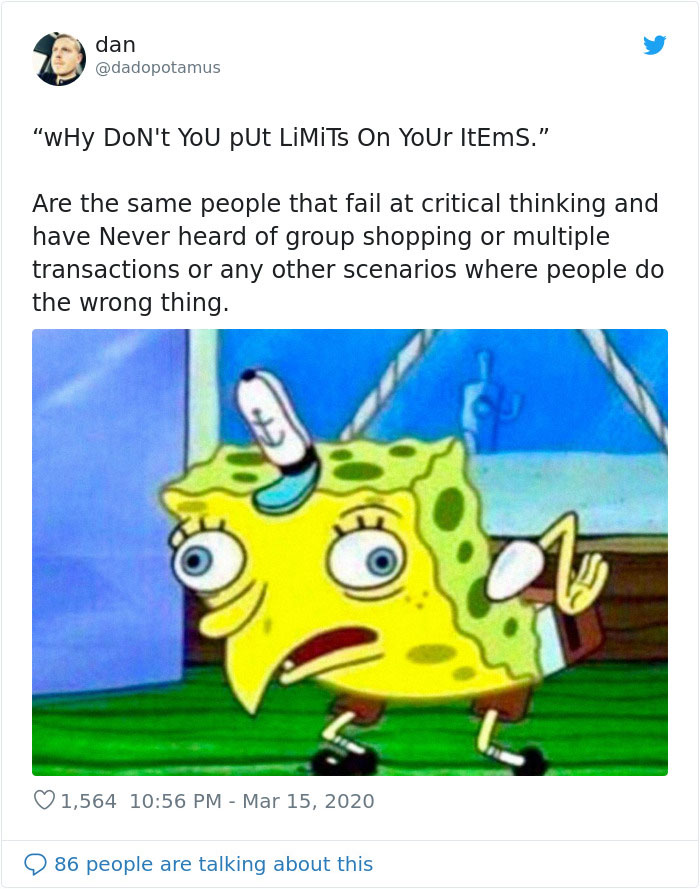
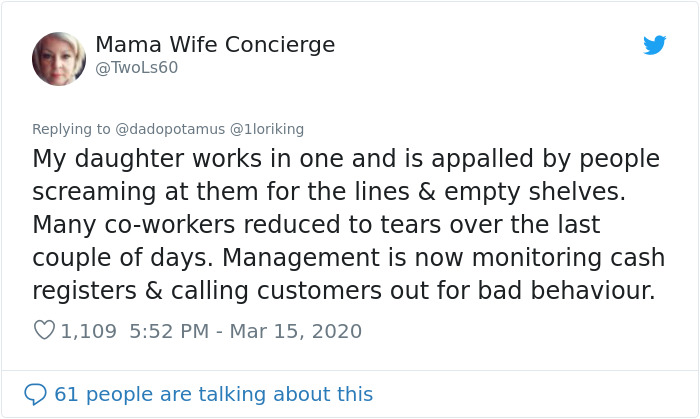
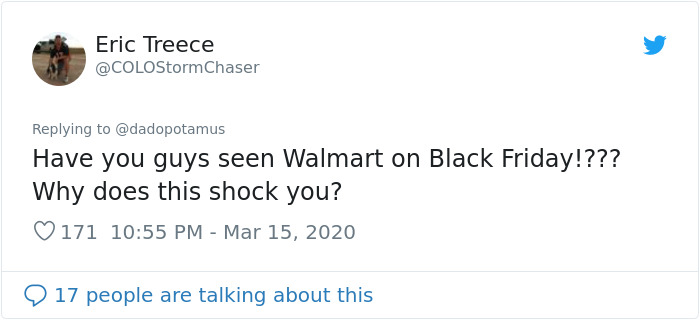
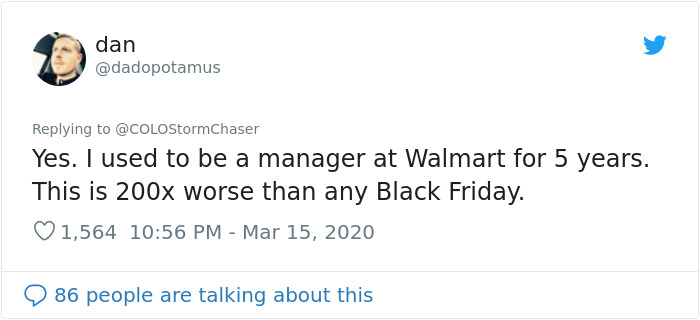
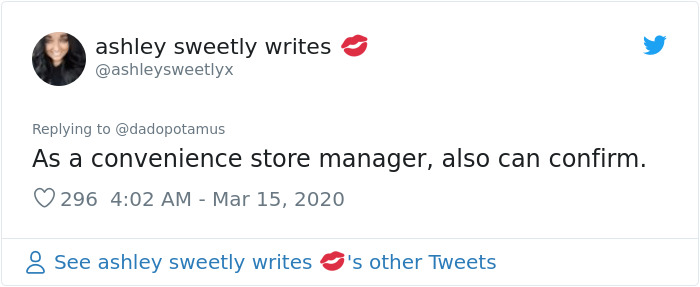
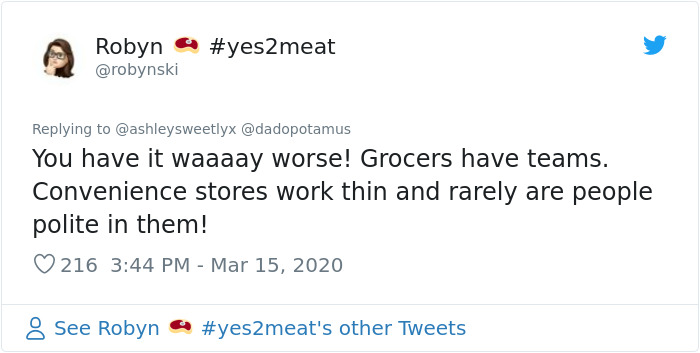
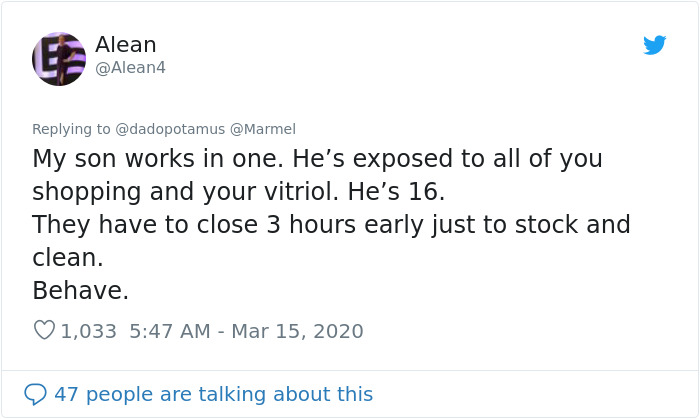
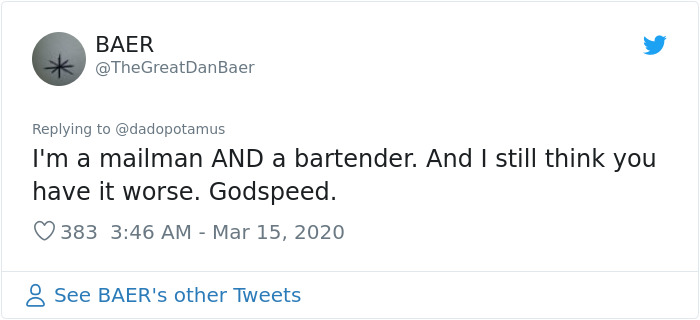
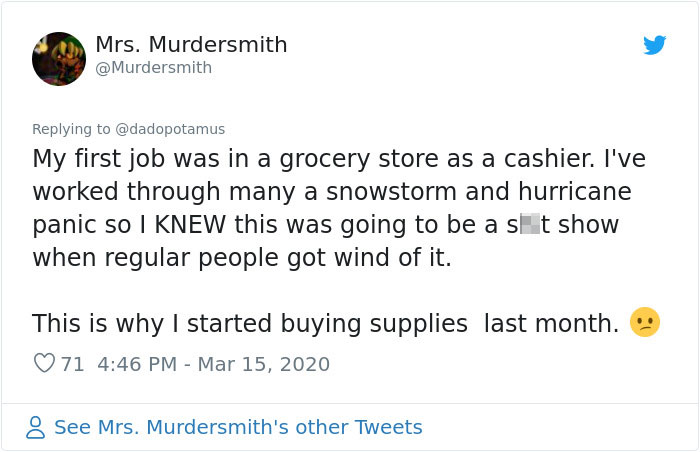
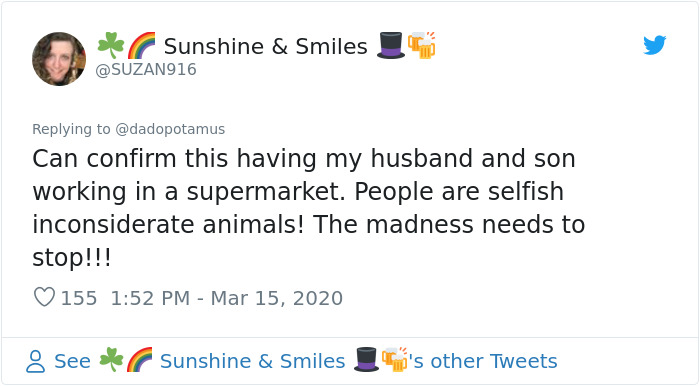
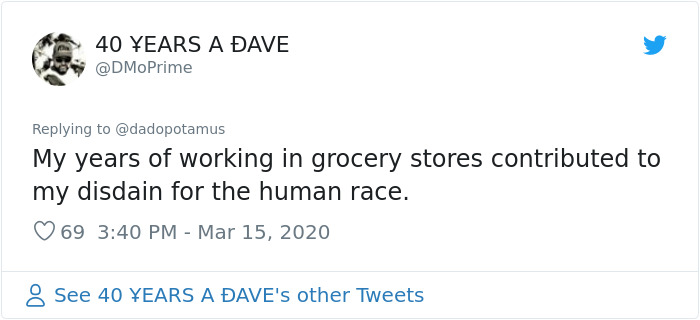
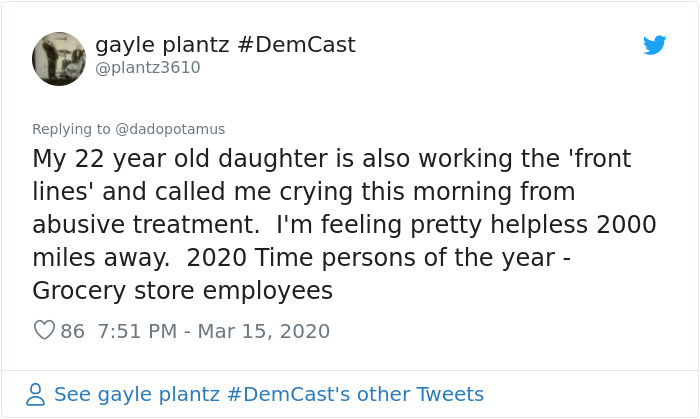
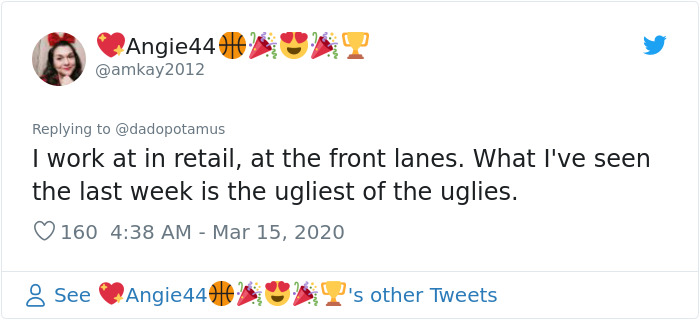
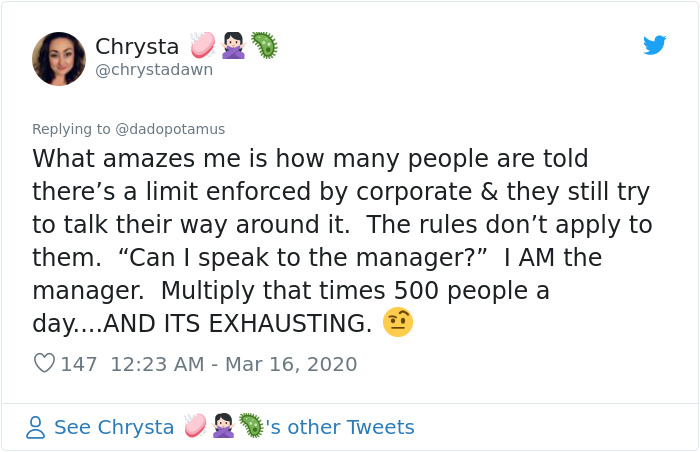
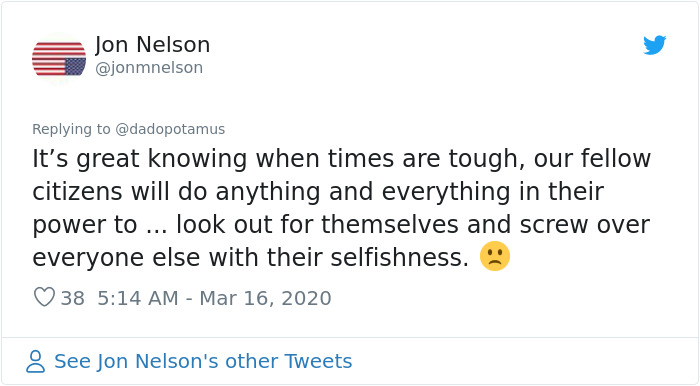
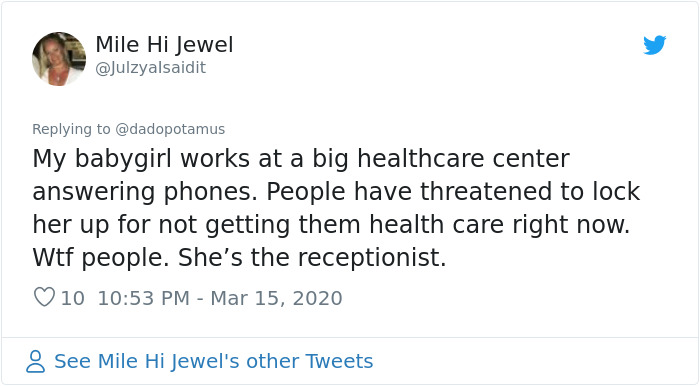
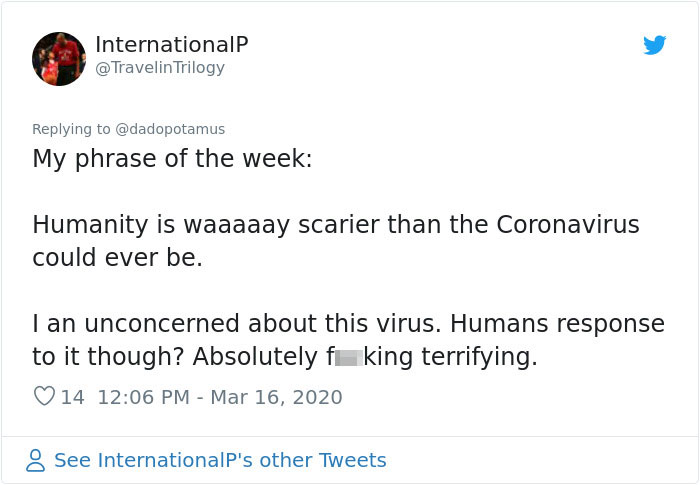
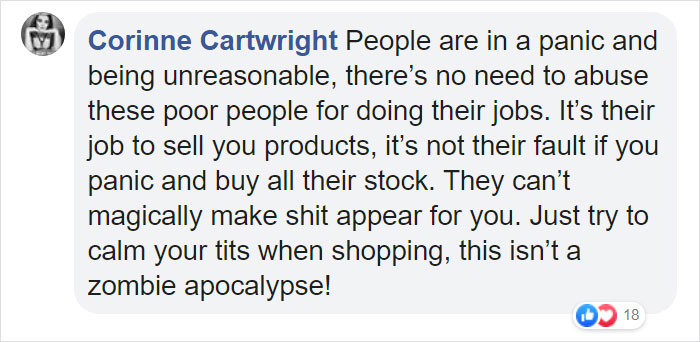
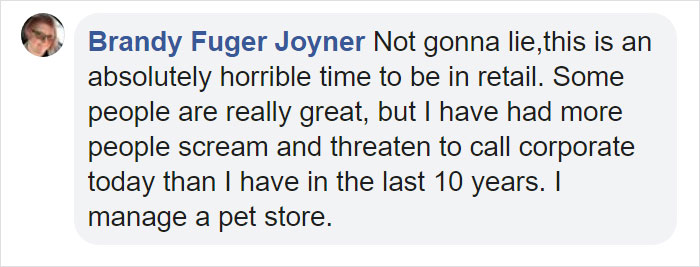
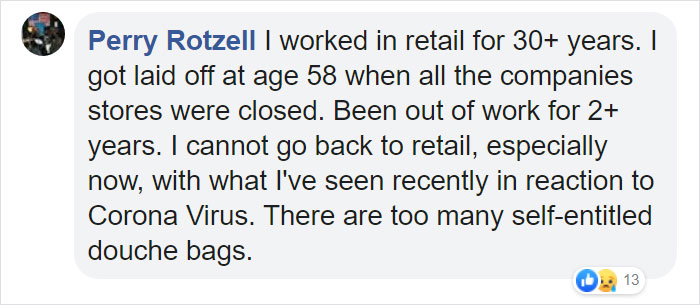
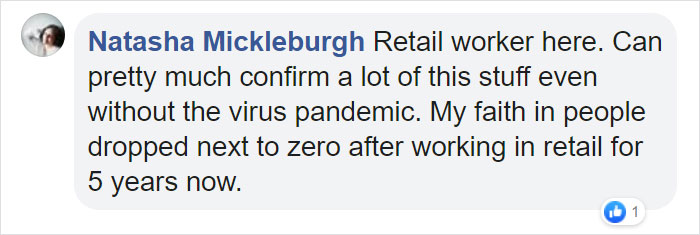
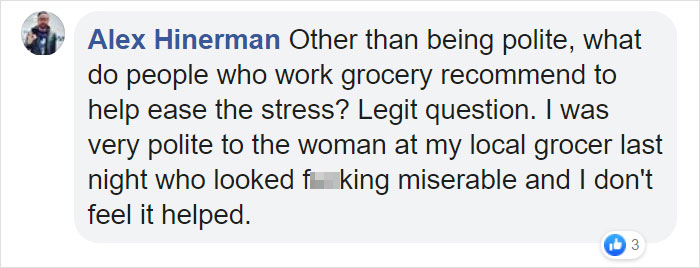
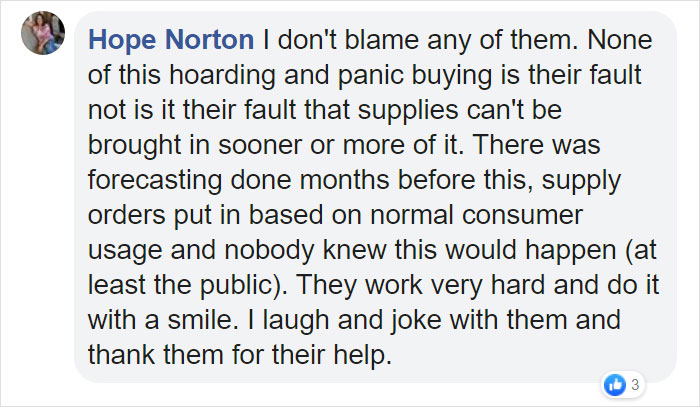





117
31